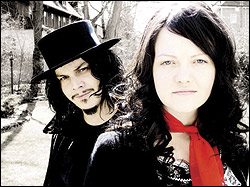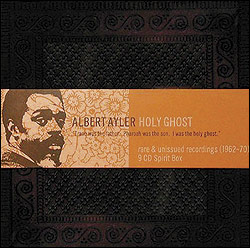Q: Why a Tegan and Sara cover?
A: Because they’re identical twins, just like the White Stripes, and this makes the White Stripes their twins, too. Or: Because their version only came out a year ago, and wasn’t a hit, and the White Stripes saw their opening and pounced, and when’s the last time you heard a great cover that worked that way? Don’t say “Don’t Cha.” Or: Because it’s the kind of rock koan Jack loves best. Think of the eight-line perfection of “Little Room,” then beat that goal by three lines. That’s Tegan and Sara’s original version of “Walking With a Ghost,” with its little lyrical knots. It’s concentrated as Stripe-red cherry syrup, and I bet Jack coveted the riff, too.
Q: I’m sorry—knots?
A: “Go” vs. “stay,” plus are there multiple ways to stay?, plus “you’re out of my mind” vs. both the object’s obsessive presence and “out of my mind”/”out of your mind,” the after-you-my-dear-Gaston contradictions of “please don’t insist.” Which leads us insistently to the title line itself, and to dig for juice there—the unspoken “talking” concealed behind the “walking,” the “was” that contradicts the tense of every other phrase of the song except “I said.”
Q: What ghost?
A: The ghost of what they were supposed to have heralded. The White Stripes are as big as a subcultural band can get, and they’ve rammed up against their own glass ceiling. They set their sights on being the best club band in the world, which they sort of are, but that means that their distance and focus settings are all wrong for stadiums, and they’re the vanguard of nothing in particular. “Walking With a Ghost” will jump into your lap and pound you bloody if you’re one of 120 people in the club, and the version they just released as a single puts you right there. In the biggish halls and amphitheaters they’re playing now, though, it’s vague and discontented, paralyzed by its repetitions: at best, a bonbon for cover-spotters who might catch Jack and Meg doing Dylan or Dolly on another night.
Q: [something indistinct about Meg White]
A: Shut up.
Q: What’s the backward bit?
A: I put the thing down, flipped it, and reversed it, so you don’t have to: “out of my mind.” Happy?
Q: So what’s the difference between the two?
A: Beyond the general, mmm, White Stripes–ifying, like Meg avoiding T&S’s muso-pop tippy-tap drum entrance in favor of delaying it a few beats so she can whack two exclamation points apiece into place for Jack’s “I!! Said!!,” there are three differences between the two versions: the true one, the false one, and the subtle one. True: The one indisputable change Jack White makes is one word of the lyric, when “insist” becomes “exist” near the end. A showboating fumble, I think: “Please don’t exist,” har har, he’s talking to a ghost and naturally they don’t exist! To the land of red hellfire and no white spirits with that, I say.
Q: Bold of you. False?
A: A bundle of buffs have already opined that pale Jackie doesn’t get the first chord of That Riff right. Box my ears gently if you must, but that’s sort of wrong and sort of the idea. T&S start with a genteel acoustic F#-minor chord, and Jack substitutes a super-distorted F#5 power chord. That means he’s keeping it a secret whether he’s thinking major or minor, and he compounds the ambiguity because every time T&S’s melody calls for him to sing an A over that chord—on the word “matter”—he sings it a little bit sharp. If you hear it as an A#, that means it completes an F#-major chord. If you hear it as an A, it’s Tegan and Sara’s original minor chord. It’s an old blues trick.
Q: Because Jack White is sooo blues. Have I mentioned that I care nothing for your F#-whatsis?
A: Doesn’t matter. Your ears notice this stuff anyway. Don’t be snotty, by the way.
Q: Fine. Subtle?
A: The thing that gels both versions of “Walking With a Ghost” is body English—the way Tegan and Sara pronounce “was” to rhyme with “floss,” for instance, and Jack’s own tongue-wrangling of “ghost” into “gaaost.” T&S have less core muscle in their interpretation (there’s that prog synthesizer swooping ghostily around the mix, the sort of thing with which the Whites would have no truck), but that doesn’t mean Jack and Meg aren’t actually weirder. Crank up the White Stripes, and you hear ghost chatter: the feathery specter touches that punctuate the two-ton downstrokes, the pitch shift in the backward section near the end that makes Jack evaporate into digital fog while stalwart Meg patrols the beat to make sure its borders don’t shift an inch.
Q: Where do they walk?
A: South for a minute, west for a minute, north for a minute, and they’re back where they started, at the North Pole, with the red and white candy stripes going up around it. It’s a Christmas present. They’re very cold and shuddering as something that doesn’t exist moves away from them.








